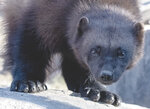Mostly Cloudy, 65° F
Ahmari, one of ZooMontana’s two wolverines, gave birth to one female kit Feb. 6, the third wolverine to be born at ZooMontana. The baby is rather large, and is being well cared for by mom. As …
This item is available in full to subscribers.
The Powell Tribune has expanded its online content. To continue reading, you will need to either log in to your subscriber account, or purchase a subscription.
If you are a current print subscriber, you can set up a free web account by clicking here.
If you already have a web account, but need to reset it, you can do so by clicking here.
If you would like to purchase a subscription click here.
Please log in to continue |
|


Ahmari, one of ZooMontana’s two wolverines, gave birth to one female kit Feb. 6, the third wolverine to be born at ZooMontana. The baby is rather large, and is being well cared for by mom. As he was last year, the father, Sid, is interested, but is being kept at a distance by Ahmari.
The zoo’s two wolverines are part of a special conservation effort that has been ongoing since their arrival from two Scandinavian countries in 2017. The program, which is sponsored by the European Association of Zoos and Aquariums (EAZA), is designed to save a genetically pure line of the species and with the hopes of boosting wild populations if they crash. The zoo is one of only three in the U.S. to have a successful captive breeding program.
After years of hoping, zoo officials were proud to announce the miracle of birth for their first litter, two males named Kovaa and Villi, in early 2023. The February birth brings the zoo’s total in the conservation program to three, and counting.
The kit was first heard by animal caregivers, and later found nursing in a den within the wolverine night house. Lead caregiver Melissa Roman is thrilled with the birth.
“It is extremely exciting to have kits two years in a row,” Roman said. “As one of the few U.S zoological parks that have been successful with wolverine births this year, we’re pretty proud of Ahmari.”
Wolverine kits are born completely white, blind and weigh less than 1 pound. They will wean within 10 weeks, developing rapidly and reaching adult size by the end of the year.
The kit will be named in an internal staff vote this time, but has yet to be decided, said ZooMontana Executive Director Jeff Ewelt. The zoo will announce the results of the vote as soon as a name is chosen.
Ewelt said he and ZooMontana caretakers allow Ahmari to “do her thing” without interruptions. The crew will keep their distance. Wolverines typically raise their kits in snow tunnels in the wild and are known to abandon their young if their habitat isn’t perfect. They even have the ability to delay pregnancy, called embryonic diapause, until circumstances improve.
The predators are found in remote boreal forests throughout the Northern Hemisphere. U.S. populations have struggled due to climate change and habitat loss, with current estimates putting the U.S. population at about 300 animals. Known for their ferocity and strength in proportion to their size, wolverines are the largest member of the Mustelidae family, which includes otters, minks and weasels.
The U.S. Fish and Wildlife Service in December announced protections for the distinct population segment of the wolverine in the lower 48 as a threatened species under the Endangered Species Act. In Wyoming the species is extremely rare, though a small population exists in Park County in Yellowstone National Park and the Shoshone National Forest, as well as occasional reports of sightings further south.
Wolverines are now similarly protected to the area’s distinct population of grizzly bears. Grizzly bears in the 48 contiguous states are also currently protected as a threatened species and, like the wolverine, have stable populations in Alaska and Canada.
ZooMontana is a nonprofit 501 (c) (3) educational organization committed to the best in animal care, conservation and wildlife education. As Montana’s only zoological and botanical park, ZooMontana is dedicated to wildlife education and conservation. The zoo is located at 2100 S. Shiloh Rd. in Billings, MT, just off the Zoo Drive exit (443) of Interstate 90.